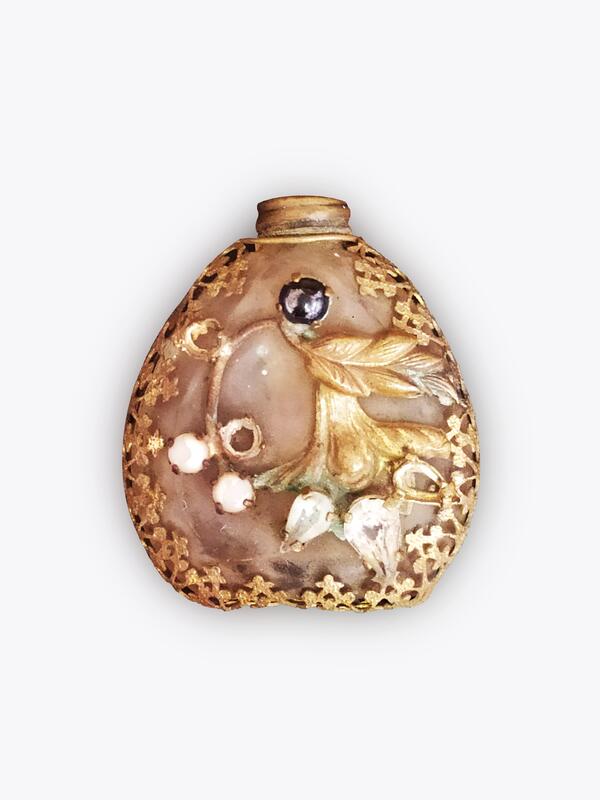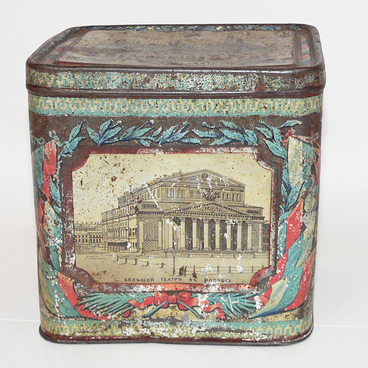This bottle for perfume, created around the beginning of the 20th century, is part of the collection in the Kótlas Museum of Local Lore. It is a sleek, clear, colorless glass bottle. It was given a flattened shape, like a flask, with round edges. The neck is narrow, with a screw-shaped thread so that a cap may be screwed on.
On the sides and bottom of the bottle there is a vine pattern, which is laid as a single narrow patterned strip of punched iron, in a tone of earthen gold. The strip fits tightly to the bottle, as if enveloping it along the edge. On the front, the bottle is decorated with a metal stem with leaves and a flower. The flower was rendered with three drop-shaped inserts made of transparent colorless glass; today one of these glass inserts is lost. Next to the leaves, there is one glass round black insert covered with black enamel - if you bring it up to the light, it reflects different colors. There is also one insert in the middle of the stem, but it too is lost. At the end of the stem there are three round-shaped inserts like pearls, of which one is lost. The metal braiding is fixed around the neck with a round, thin metal wire.
The growth in the production of perfumery products took place primarily in the 17th to 18th centuries. The vessels for perfumes and essences were also very diverse. In perfumery shops, uncomplicated bottles were displayed, in shapes not much different from pharmaceutical bottles or wine bottles of that time. People bought perfumes and colognes in simple containers and then transferred them into beautiful vessels. This state of affairs continued almost until the end of the 19th century; only the style of the decorative vessels and the technology of processing glass and metals changed. Reinforcement of glass with metallic decorative elements — from purely ornamental adornments to pastoral scenes — has become a popular technique. Cut iron, which was often used to decorate and strengthen the bottles, is a simple strip with holes from which the pattern was formed.
Frenchman Alfonso Ralle was the founder of the perfumery business in Russia. In 1843 he opened a small candle-making factory in Moscow. Very soon, Ralle had amassed sufficient capital to expand to perfume, and his modestly sized production company became known as ‘A. Ralle and Co.’ Before this time, there was no large-scale production of perfumery in the Russian Empire, and subsequently, the development of the industry proceeded at a rapid pace.
On the sides and bottom of the bottle there is a vine pattern, which is laid as a single narrow patterned strip of punched iron, in a tone of earthen gold. The strip fits tightly to the bottle, as if enveloping it along the edge. On the front, the bottle is decorated with a metal stem with leaves and a flower. The flower was rendered with three drop-shaped inserts made of transparent colorless glass; today one of these glass inserts is lost. Next to the leaves, there is one glass round black insert covered with black enamel - if you bring it up to the light, it reflects different colors. There is also one insert in the middle of the stem, but it too is lost. At the end of the stem there are three round-shaped inserts like pearls, of which one is lost. The metal braiding is fixed around the neck with a round, thin metal wire.
The growth in the production of perfumery products took place primarily in the 17th to 18th centuries. The vessels for perfumes and essences were also very diverse. In perfumery shops, uncomplicated bottles were displayed, in shapes not much different from pharmaceutical bottles or wine bottles of that time. People bought perfumes and colognes in simple containers and then transferred them into beautiful vessels. This state of affairs continued almost until the end of the 19th century; only the style of the decorative vessels and the technology of processing glass and metals changed. Reinforcement of glass with metallic decorative elements — from purely ornamental adornments to pastoral scenes — has become a popular technique. Cut iron, which was often used to decorate and strengthen the bottles, is a simple strip with holes from which the pattern was formed.
Frenchman Alfonso Ralle was the founder of the perfumery business in Russia. In 1843 he opened a small candle-making factory in Moscow. Very soon, Ralle had amassed sufficient capital to expand to perfume, and his modestly sized production company became known as ‘A. Ralle and Co.’ Before this time, there was no large-scale production of perfumery in the Russian Empire, and subsequently, the development of the industry proceeded at a rapid pace.



